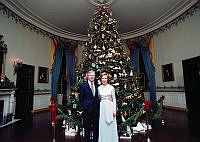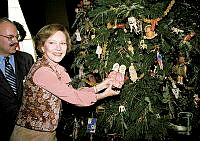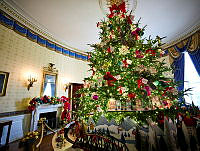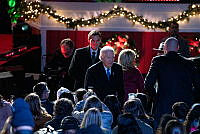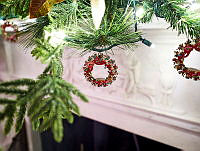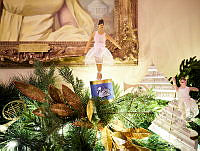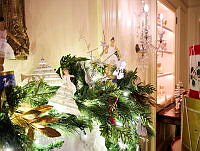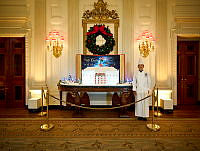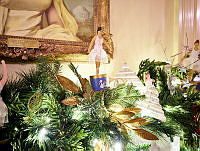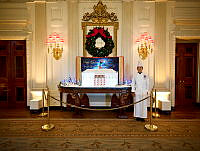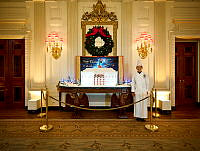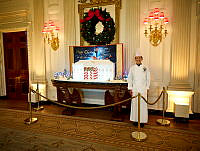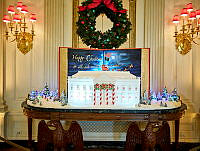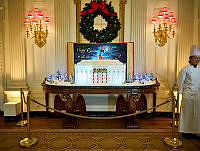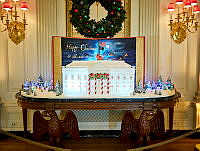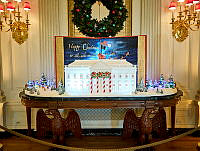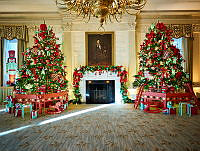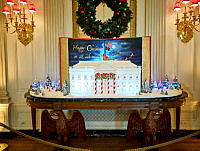Rubenstein Center Scholarship
The Life and Presidency of Lyndon B. Johnson
The Official 2021 White House Christmas Ornament historical essay
On November 22, 1963, about two hours after the assassination of President John F. Kennedy, Vice President Lyndon Baines Johnson took the Oath of Office aboard Air Force One at Love Field in Dallas, becoming the thirty-sixth president of the United States. About two weeks later, President Johnson, First Lady Claudia (“Lady Bird”) Johnson, and their daughter, Luci Baines Johnson, moved into the White House. Lynda Bird Johnson, the president’s older daughter and a student at the University of Texas-Austin, joined the family shortly thereafter.1 Prior to serving as vice president, Johnson had represented his home state of Texas for more than twenty years in both the House of Representatives and the Senate, where he honed his political skills and developed a reputation for aggressive legislative negotiations. As president, LBJ immediately set out to heal a mourning nation while advancing legislation to bolster Kennedy’s legacy.

Following the assassination of President John F. Kennedy, Lyndon Johnson stands between his wife Lady Bird (left) and Jacqueline Kennedy (right) as he takes the Oath of Office administered by Judge Sarah T. Hughes aboard Air Force One at Love Field in Dallas, November 22, 1963.
John F. Kennedy Presidential Library and Museum/NARAThroughout 1963, the United States experienced major social unrest. African Americans demanded equality under the law, challenging Jim Crow laws of the South, segregation, and racism. Abroad, President Kennedy sent additional military advisors and personnel to support anti-communist efforts in Vietnam, only to see the American-backed South Vietnamese leader Ngo Dinh Diem assassinated by a military coup. U.S. involvement in Southeast Asia had become an extension of the Cold War. The geopolitical, economic, military, and cultural conflict between the United States and the Soviet Union surged after the Bay of Pigs invasion of Cuba and the Cuban Missile Crisis. The assassination of President Kennedy at such a turbulent time escalated these national and international anxieties.
President Kennedy was buried at Arlington National Cemetery on November 25, 1963. Two days later, President Johnson spoke to a joint session of Congress, calling for passage of Civil Rights legislation stating, “No memorial oration or eulogy could more eloquently honor President Kennedy’s memory than the earliest possible passage of the civil rights bill for which he fought so long. We have talked long enough in this country about equal rights. We have talked for one hundred years or more. It is time now to write the next chapter, and to write it in the books of law.”2 The legislation presented to Congress by Kennedy the previous June had been met with strong opposition from members of his own party. LBJ’s call to action, however, was successful, benefiting from his close relationships as the former Senate majority leader.

Martin Luther King Jr. stands behind President Lyndon B. Johnson as he signs the Civil Rights Act of 1964 into law in the East Room of the White House, July 2, 1964.
Lyndon B. Johnson Presidential Library and Museum/NARAOn July 2, 1964, LBJ signed the Civil Rights Act of 1964 in the East Room, ending segregation in public places and outlawing employment discrimination on the basis of race, color, religion, or national origin. The following year, he signed the landmark Voting Rights Act of 1965, which prohibited racial discrimination practices in voting. Less than three years later, on April 11, 1968, he signed the Civil Rights Act of 1968 (also known as the Fair Housing Act), prohibiting discrimination in housing on the basis of race, religion, or national origin.3 Beyond legislation, Johnson also used his presidential authority to nominate African Americans to high positions in the federal government. He appointed Thurgood Marshall as solicitor general in 1965; two years later, he nominated him for the United States Supreme Court. Marshall’s confirmation made him the first African American to sit on the nation’s highest court.
In 1964, President Johnson was elected in a landslide, defeating Republican candidate Barry Goldwater. He continued to promote policies that enhanced Kennedy’s legacy while advancing his own vision for the country. One of his most significant initiatives was the Great Society, comprised of different programs and policies designed to address inequalities in education, health care, employment, transportation, and housing. A key component of the Great Society was the “War on Poverty,” introduced during the 1964 State of the Union Address, when LBJ declared “all-out war on human poverty and unemployment in these United States.”4 The social welfare legislation that followed aimed to reduce poverty and included the Economic Opportunity Act of 1964, which created the Office of Economic Opportunity; established the Job Corps; and enacted Head Start, an early education program for the children of impoverished families.5 During Johnson’s five years in office, his administration submitted more than eighty bills to Congress and enacted some two hundred pieces of legislation.6 Medicare, Medicaid, food stamps, immigration reform, urban renewal legislation, education funding, consumer regulations, and environmental protections were established by the Great Society.

President Lyndon B. Johnson signs the Voting Rights Act in the President’s Room at the U.S. Capitol as Martin Luther King Jr. and others look on, on August 6, 1965.
Lyndon B. Johnson Presidential Library and Museum/NARAWhile President Johnson’s list of domestic achievements is remarkable, his approach to foreign policy proved controversial. In August 1964, a confrontation between North Vietnam and the United States Navy in the Gulf of Tonkin accelerated the conflict and led to the passage of the Gulf of Tonkin Resolution, which granted President Johnson the power to “promote the maintenance of international peace and security in southeast Asia.”7 Much like his predecessors, Johnson believed that containment was the best means of preventing the spread of communism. As a result, he deployed additional U.S. forces to Vietnam, resulting in open warfare with North Vietnam. By the end of LBJ’s presidency more than 500,000 American soldiers were fighting in Vietnam, and more than 30,000 Americans had lost their lives. The war became increasingly polarizing, prompting countless antiwar protests and demonstrations. In addition, the economic cost of the Vietnam War limited the effectiveness of Johnson’s Great Society programs.8

President Lyndon Johnson bows his head in the Cabinet Room while listening to a tape recorded message made by his son-in-law Captain Charles Robb in Vietnam, July 31, 1968.
Lyndon B. Johnson Presidential Library and Museum/NARAAlthough President Johnson pursued interventionism in Vietnam, he enacted some conciliatory policies with the Soviet Union, including the 1967 Outer Space Treaty banning nuclear weapons in space and the 1968 Non-Proliferation Treaty. He also oversaw the development of the U.S. space program in a bid to beat the Soviet Union in the race to the moon, welcoming astronauts to the White House following successful Gemini and Apollo missions. Although President Kennedy is widely credited for the accomplishments of the U.S. space program, Johnson was involved from its inception. During his time as Senate majority leader, LBJ lobbied to create NASA following the 1957 Soviet launch of Sputnik 1. While serving as vice president, LBJ was Kennedy’s choice to chair the National Aeronautics and Space Council, a White House advisory group, and successfully persuaded Kennedy to support and promote the space race with the Soviet Union.9

President Lyndon B. Johnson awards the Exceptional Service Medal to astronaut Colonel Gordon Cooper in the Oval Office as Cooper’s family looks on. Cooper was the command pilot for the Gemini 5 mission, August 21–29, 1965, which broke the Soviet record for spaceflight duration. The Gemini 5 mission would be Cooper’s last before his retirement. He was one of the seven original Project Mercury astronauts and flew “Faith 7,” the Mercury-Atlas 9, mission that orbited the earth twenty-two times over roughly thirty-four hours.
White House Historical AssociationIn addition to his foreign and domestic policy initiatives, Johnson continued President and Mrs. Kennedy’s support of the arts and humanities. His administration helped establish the National Endowment for the Humanities and the National Endowment for the Arts in 1965, and in 1968 he signed the Public Broadcasting Act that established the Corporation of Public Broadcasting and later led to the creation of the Public Broadcasting Service (PBS) and National Public Radio (NPR). President and Mrs. Johnson hosted numerous White House events that promoted the arts and humanities, including the 1965 Festival of the Arts. The Johnsons also furthered Mrs. Kennedy’s vision of the White House as a living museum. In March 1964, President Johnson signed Executive Order 11145, creating the official position of White House curator and establishing the Committee for the Preservation of the White House.10 In honor of her predecessor, Lady Bird Johnson completed the redesign of the East Garden and renamed it the Jacqueline Kennedy Garden in 1965.11 Mrs. Johnson was also involved in creating The Living White House, the White House Historical Association’s third book, which is now in its fourteenth edition. Proceeds from the sale of The Living White House continue to support the Association’s educational mission. As first lady, Mrs. Johnson also pursued the beautification of urban neighborhoods to promote conservation and community renewal, utilizing native plants and wildflowers to create sustainable landscapes.

Guests view sculptures in the recently unveiled Jacqueline Kennedy Garden during the White House Festival of the Arts, June 14, 1965.
National Archives and Records AdministrationIn a televised address on March 31, 1968, President Johnson announced his decision not to seek reelection: “I shall not seek, and I will not accept, the nomination of my party for another term as your President.”12 Following his presidency, LBJ retired to his ranch in Stonewall, Texas. On January 22, 1973, he suffered a fatal heart attack at the age of sixty-four. Mrs. Johnson continued to be involved with beautification efforts, the LBJ Presidential Library, and a variety of other causes. She died on July 11, 2007, and was laid to rest next to her husband in the Johnson Family Cemetery at the LBJ Ranch.
Johnson Family Holiday Traditions
President Lyndon Johnson and his family spent many Christmas Days at the LBJ Ranch in Stonewall, Texas, but during the first weeks of December he and First Lady Lady Bird Johnson continued many White House holiday traditions. They hosted annual White House Christmas receptions and gave gifts to staff members. LBJ lit the National Christmas Tree every year, a custom begun by President Calvin Coolidge in 1923. Like Jacqueline Kennedy, Mrs. Johnson selected themes and festively decorated the White House with trees, garlands, wreaths, and ribbons. Mrs. Johnson also created new holiday traditions such as the annual Christmas party for the children of diplomats; and receiving the National Christmas Tree Association champion tree for display in the Blue Room. The eighteenth-century Neapolitan crèche she accepted for the White House Collection continues to be displayed in the East Room during the holiday season.
Although the Johnsons initially celebrated Christmas in Texas, they changed course in 1967, opting to stay in Washington, D.C. This was perhaps a result of major life changes within the Johnson family. In 1966, daughter Luci married Patrick Nugent. The couple had their wedding reception at the White House, and welcomed their first child, Patrick Lyndon Nugent, the following year, making the president and first lady grandparents. On December 9, 1967, about six months after Patrick’s arrival, Lynda Bird Johnson married Charles Robb in the East Room. The next year, they too became parents with the arrival of Lucinda Desha Robb. By then President Johnson had announced that he would not seek another term.

Left to right; Luci Johnson Nugent, Patrick Lyndon Nugent, First Lady Lady Bird Johnson, President Lyndon Johnson with dog Yuki, Lynda Johnson Robb, and Lucinda Robb sit on a couch in the Yellow Oval Room in the private residence on the second floor of the White House on December 24, 1968.
Lyndon B. Johnson Presidential Library and Museum/NARABefore they left the White House, Mrs. Johnson created something special for future presidential grandchildren who would visit there: The Children’s Garden. This special garden on the South Lawn features a small fishpond, child-sized chairs, and plaques of grandchildren’s handprints and footprints set into a flagstone terrace—the first sets of prints made for the garden belonged to Patrick and Lucinda. The garden was given to the White House by the Johnsons at Christmas 1968, and Mrs. Johnson dedicated it on January 19, 1969, the day before they left the White House.
The Lyndon B. Johnson Ornament Design
The White House Historical Association’s 2021 Official White House Christmas Ornament commemorates the presidency of Lyndon Baines Johnson. One side of the ornament features a painting of the 1967 Blue Room Christmas tree. Mrs. Johnson requested that Robert H. Laessig, a designer for American Greetings, paint the official Christmas tree in the Blue Room for their card that year. The 1967 White House Christmas card was sent out by President and Mrs. Johnson to White House staff members, family, and friends.13

The Official 2021 White House Ornament honors the presidency of Lyndon B. Johnson, the 36th President of the United States. The front of the ornament captures Robert H. Laessigs painting of the 1967 Blue Room Christmas tree. Laessig, a designer with American Greetings, painted the tree at the request of First Lady Lady Bird Johnson for the Johnson family's Christmas card that year.
David Wiegold for the White House Historical AssociationOn the other side of the ornament, there is a quote from President Johnson: “Our mission is at once the oldest and the most basic of this country: to right wrong, to do justice, to serve man.”14 The president spoke these words to a joint session of Congress on March 15, 1965, calling on legislators to support a bill that would protect the right to vote and outlaw discriminatory measures that prevented African Americans from voting. Johnson’s speech was a response to the violence in Selma, Alabama, where Civil Rights activists were attacked by law enforcement and counter protesters while crossing the Edmund Pettus Bridge. The speech was later remembered by its most famous line, “We Shall Overcome.”
The flowers encircling the quote are inspired by Lady Bird Johnson’s beautification programs on the White House Grounds and throughout Washington, D.C. These are Texas bluebonnets—a favorite of Mrs. Johnson and the official state flower of Texas.














